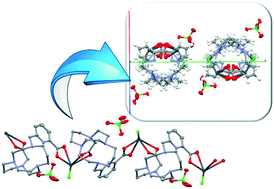A different approach: highly encapsulating macrocycles being used as organic tectons in the building of CPs†
Abstract
For the first time, a highly encapsulating macrocycle derived from the cross-bridged cyclam platform has been used to build coordination polymers. The bibracchial dissymmetric lariat macrocycle H2cb-teapa works as an organic tecton yielding a Pb(II) 1D coordination polymer of formula {[Pb(Cl)(H2cb-teapa)](ClO4)}n (4), whose structure has been analysed by single crystal X-ray diffraction. As a result of its proton sponge behavior, H2cb-teapa adopts a zwitterionic form which actually prevents the endocyclic coordination of the Pb(II) ion and allows this cation to act as the expected external bridge. Notably, the polymer adopts a singular and interesting tube-like structure, which results from the alternation of the Λ and Δ enantiomers generated by the layout of the arms of the organic linker. Analysis of the natural bond orbitals (NBOs) in the crystal confirmed that the Pb(II) lone pair is polarized by a certain 6p contribution thus indicating that it is stereochemically active. Likewise, in order to gain insight into the structural role, as well as the coordinating capability of the perchlorate groups, QTAIM analysis has also been performed.

- This article is part of the themed collection: Coordination Networks


 Please wait while we load your content...
Please wait while we load your content...